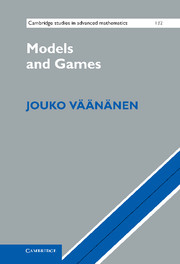5 - Models
Published online by Cambridge University Press: 01 June 2011
Summary
Introduction
The concept of a model (or structure) is one of the most fundamental in logic. In brief, while the meaning of logical symbols ∧, ∨, ∃, … is always fixed, models give meaning to non-logical symbols such as constant, predicate, and function symbols. When we have agreed about the meaning of the logical and non-logical symbols of logic, we can then define the meaning of arbitrary formulas.
Depending on context and preference, models appear in logic in two roles. They can serve the auxiliary role of clarifying logical derivation. For example, one quick way to tell what it means for φ to be a logical consequence of ψ is to say that in every model where ψ is true also φ is true. It is then an almost trivial matter to understand why for example ∀x∃yφ is a logical consequence of ∃y∀xφ but ∀y∃xφ is in general not.
Alternatively models can be the prime objects of investigation and it is the logical derivation that is in an auxiliary role of throwing light on properties of models. This is manifestly demonstrated by the Completeness Theorem which says that any set T of first-order sentences has a model unless a contradiction can be logically derived from T, which entails that the two alternative perspectives of models are really equivalent. Since derivations are finite, this implies the important Compactness Theorem: If a set of first-order sentences is such that each of its finite subsets has a model it itself has a model.
- Type
- Chapter
- Information
- Models and Games , pp. 53 - 78Publisher: Cambridge University PressPrint publication year: 2011
- 1
- Cited by



